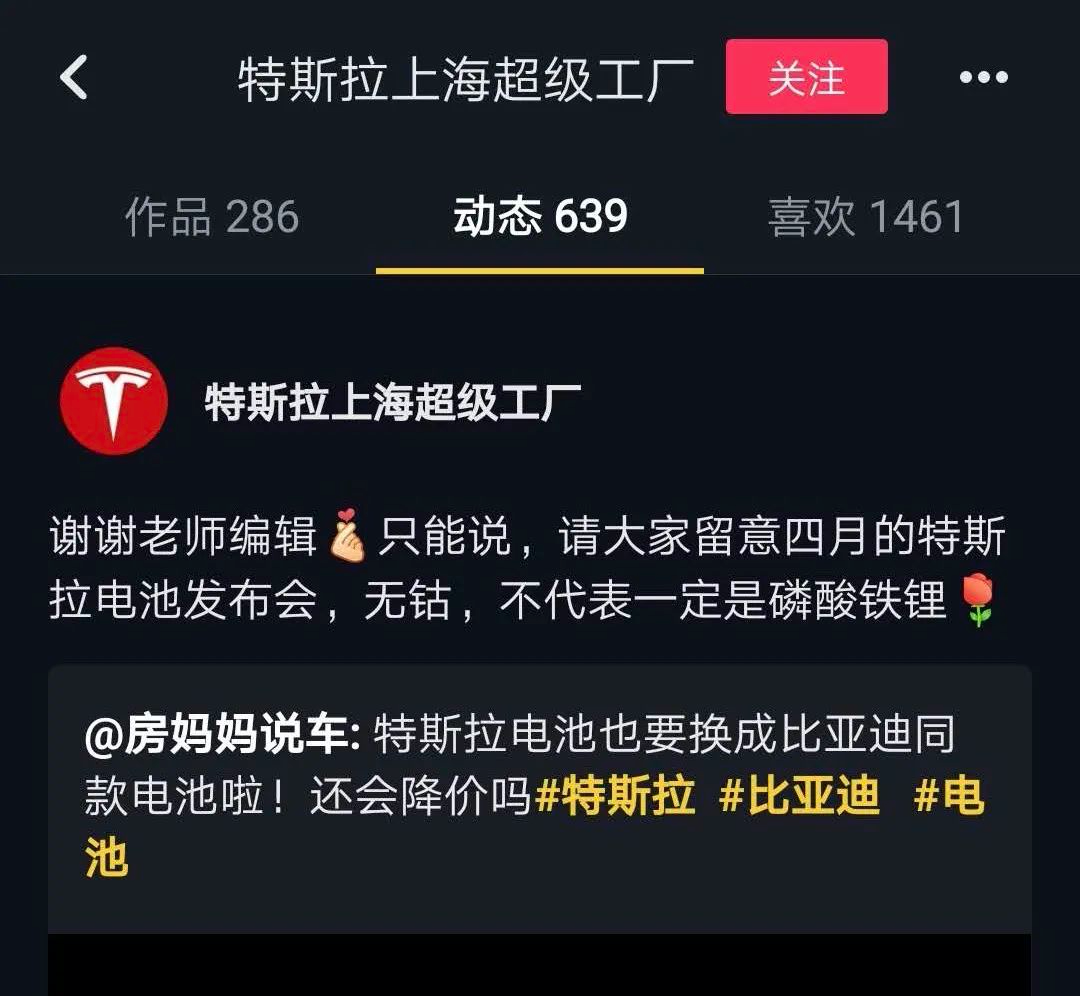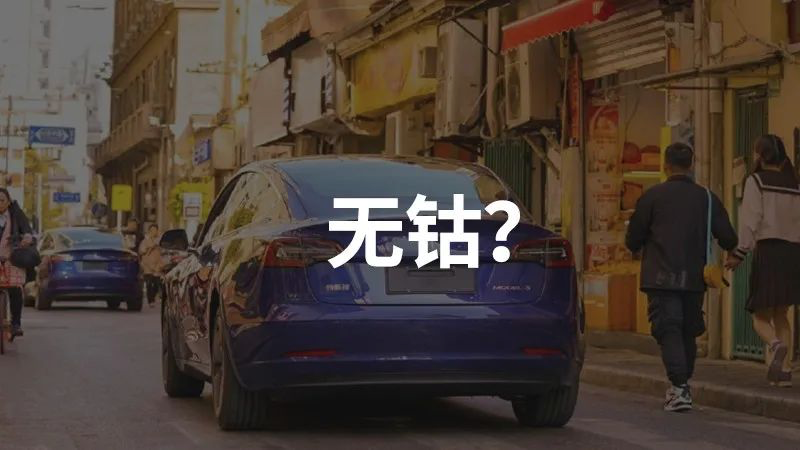Yesterday evening, a colleague suddenly sent me a picture.

The official TikTok account of Tesla Shanghai Gigafactory implied in a comment in the picture that “cobalt-free does not necessarily mean lithium iron phosphate.”
When I saw this sentence, I was scared and trembled. Could our intelligence be wrong?
After calmly analyzing it, I came to a clear conclusion: Tesla will release cobalt-free ternary lithium batteries on Battery Day in April, but they cannot be used on the domestic Model 3, let alone the standardRange Plus version, which is the base Model 3.
Later, I opened the official TikTok account of Tesla Shanghai Gigafactory and found that the reply had been deleted.
This seems to imply that the meaning of “cobalt-free does not necessarily mean lithium iron phosphate” is inaccurate.
So what is the accurate meaning? Is it confirmed that lithium iron phosphate is used?
Let’s start from the beginning.
Can CATL produce cobalt-free batteries on a large scale?
There are currently two pieces of information that can be confirmed. Firstly, Tesla has reached a cooperation with Contemporary Amperex Technology Co. Ltd (CATL), which will supply Tesla with lithium-ion batteries starting in July 2020. Secondly, CATL will supply Tesla with cobalt-free batteries. As for which kind of cobalt-free battery, opinions vary, and a hint from the official account has made things confusing.
To figure out this problem, we need to know if CATL has the capability to produce cobalt-free batteries on a large scale.
Currently, the mainstream lithium-ion power batteries are divided into two types: “lithium iron phosphate” and “ternary lithium”
Lithium iron phosphate batteries have iron as the positive electrode material, without “cobalt” element. Although no one cares that this kind of battery is called “cobalt-free” battery, theoretically, it is also okay for you to call it a “cobalt-free” battery.
The power batteries currently used in passenger vehicles are mainly ternary lithium batteries. As the name suggests, the positive electrode is composed of three elements: “nickel”, “cobalt”, and “manganese”. When the proportion of “cobalt” drops to 0%, this is called cobalt-free ternary lithium batteries.
LiFePO4 batteries have been widely used in pure electric vehicles five years ago, but because the policy requires higher energy density for passenger cars, the parameter characteristics of LiFePO4 batteries do not match the policy requirements and have gradually exited the passenger car market. However, in large vehicles such as buses and trucks with large volumes and low requirements for energy density, they are still widely used.In 2019, CATL’s shipment volume was 32.87 GWh, with 11.3 GWh, or 34\%, being lithium iron phosphate. But what about cobalt-free ternary lithium batteries?
In recent years, ternary lithium batteries have been trending towards cobalt-free. On the one hand, the cost of cobalt is relatively high, and reducing its usage can effectively lower the material cost of the battery. On the other hand, with its reduced usage, the proportion of nickel in the cathode material increases. The higher the proportion of nickel in the cathode material, the higher the energy density of the battery, and the more energy can be stored under the same weight. But although this sounds ideal, there are still high technical barriers to achieving cobalt-free ternary lithium battery mass production in domestic and foreign battery factories.
The increasing proportion of nickel in the cathode will lead to an increase in the battery’s activity, resulting in an inevitable decrease in its stability. In addition, after reducing the proportion of cobalt, the fast-charging performance of the battery will also be weakened. Therefore, in order to reduce the proportion of cobalt in ternary lithium batteries, we must overcome the two problems of poor safety and slow charging speed.
Currently, the ternary lithium battery with the lowest proportion of cobalt in mass production by CATL is the 811 ternary lithium battery. If we consider the technology that can be mass-produced, a 10\% cobalt content is already a relatively extreme level for CATL. In May 2019, CATL started delivering the 811 ternary lithium battery for use in vehicles, but due to the high difficulty of production, the yield was not ideal. The high production difficulty and less than ideal yield also resulted in no price advantage for the 811 ternary lithium battery with less cobalt content compared to the 523 ternary lithium battery with higher cobalt content.
Therefore, from a technical point of view, CATL does not currently have the ability to mass-produce high-nickel and cobalt-free batteries.
Can Tesla make cobalt-free batteries?
It is highly possible.
Friends who are familiar with Tesla may know that the widely circulated saying is that the NCA ternary lithium 2170 battery cell used in the Model 3 is in a ratio of 9:0.5:0.5, with the proportion of cobalt already reduced to 5\%, which is lower than the current mainstream level of 10\%. However, in June 2018, Elon Musk stated on Twitter that the proportion of cobalt in the 2170 battery cell had already been reduced to less than 3\%, and the next generation product will be cobalt-free.In the Q1 2018 earnings conference call, Elon and CTO JB.Straubel mentioned that Tesla has been committed to reducing the use of “cobalt” in batteries, which can effectively reduce the cost of batteries. Although we cannot completely eliminate cobalt now, we are working towards this trend.
Thinking about the 2019 acquisition of Maxwell, the new battery production line built by Tesla Fremont, and the new technology to be unveiled at Battery Day in April, all of these point to “cobalt-free” ternary lithium batteries.
So if Tesla has the technology to manufacture “cobalt-free” ternary lithium batteries, is it possible to supply them to CATL and then use them in domestic Model 3?
Impossible.
CATL’s batteries for Tesla have entered the product verification stage and will be installed in vehicles in July, and these vehicles are only limited to the domestic Model 3 standard range upgrade version. Tesla has no reason to use new technology first in entry-level models, and it is specifically for the Chinese version.
I firmly oppose some analysts who confuse the foresighted technology research and development of manufacturers with the procurement of components for entry-level models, and believe that this is a technological setback for Tesla. This is a very wrong statement.
But what I do not deny is that lithium iron phosphate has indeed returned to the public’s view and will occupy a place.
When many people talk about Tesla, they view NCA cylindrical batteries as Tesla’s technical obsession. Yes, I used to think so too. But why does Tesla make such a choice?
When focusing on issues such as choice strategy, we should not be obsessed with technical details, but understand first what goals Tesla wants to achieve.
Looking back at Tesla’s strategic goals
Let’s look back at Tesla’s strategic goals.
Tesla’s vision is to drive the world towards sustainable energy. In August 2006, Elon formulated a product plan:
-
Make a sports car (Roadster)
-
Then use the money earned to develop a car that more people can afford (Model S\&X)
-
Then use the money earned to create a more affordable car that more people can buy (Model 3\&Y)
-
Provide zero-emission power options (Solar Roof).
Tesla’s goal is to “drive the world towards sustainable energy” and has always viewed gasoline cars as competitors. This goal has not changed for 14 years.
 The significance of the Tesla Shanghai factory is to lower the prices of vehicles further by localizing and scaling, ultimately improving sales.
The significance of the Tesla Shanghai factory is to lower the prices of vehicles further by localizing and scaling, ultimately improving sales.

New technology is difficult to have high cost-effectiveness in the first two years after its introduction to the market. Therefore, for the domestic Model 3, using CATL’s lithium iron phosphate batteries is a more cost-effective choice.
In the article “Tesla’s Cobalt-Free Battery Case,” we have already analyzed the feasibility of the domestic standard range-upgraded version Model 3 using lithium iron phosphate batteries.
The Cell-to-Pack technology can effectively improve the energy density of battery packs, partly solving the low energy density problem of lithium iron phosphate batteries, which can satisfy the demand of the standard range-upgraded version for the battery capacity.
However, the adoption of CTP technology can result in a too compact structure, creating challenges for the design of the battery pack’s thermal management system. Besides, according to the measurements of some manufacturers, the charge and discharge performance of lithium iron phosphate batteries is weaker than that of ternary lithium batteries in low-temperature environments.
These disadvantages are also hurdles that Tesla needs to overcome when utilizing lithium iron phosphate batteries. As for the performance differences between Model 3 using lithium iron phosphate batteries and Model 3 using ternary lithium batteries, we can leave this curiosity until they are mass-produced in July.
As for me, I am more looking forward to the “Real Cobalt-Free Battery” announced in Tesla’s Battery Day event in April this year.
This article is a translation by ChatGPT of a Chinese report from 42HOW. If you have any questions about it, please email bd@42how.com.
